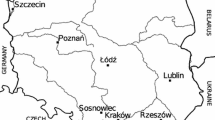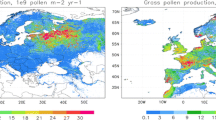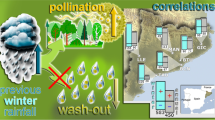Abstract
The idea has been generally accepted that accumulative properties of the lower atmosphere during stable non-turbulent air conditions by night (inversion) would lead to relatively high concentrations of airborne particles including those of biological origin like pollen grains originating from wind pollinating plants. Using temperature gradient, air pollution potential, and urban grass-pollen counts as criteria in a meteorologically homogenous region in the western part of the Netherlands, this relation between inversion and airborne grass-pollen concentration appears to be very weak and of no significance for the causation of nightly peaks in the grass-pollen counts.
Similar content being viewed by others
References
ASSEM, A. VAN DEN (1973): Daily census of airborne pollen in The Netherlands, especially in relation to hay fever. In: Airborne Transmission and Airborne Infection. Ed.: Hers en Winkler. Oosthoek, Utrecht: 364–369.
DOP, H. VAN, A. P. VAN ULDEN and W. R. RAAFF (1975): Een onderzoek naar periodes waarin meteorologisch gezien ernstige luchtverontreiniging kan optreden. Wetenschappelijk Rapport, W.R. 75-4; K.N.M.I., De Bilt: 1–10.
FUCKERIEDER, K. (1976): Der Graspollengehalt der Luft in Mittel-Europa. Berichte 9/76; Umweltbundesamt, München: 52–60.
HYDE, H. A. (1973): Atmospheric pollen grains and spores in relation to allergy. II. Clinical Allergy, 3: 109–126.
KÄPYLÄ, M. (1981): Diurnal variation of non-arboreal pollen in the air in Finland. Grana, 20: 55–59.
LEUSCHNER, R. and G. BOEHM (1981): Special weather conditions, air pollution, pollen and allergic attacks of patients. Abst. Proc. 4th Charles Blackley Symposium, Nottingham: 15–16.
MULLINS, J. (1981): Diurnal variation in grass pollen count. Abst. Proc. 4th Charles Blackley Symposium, Nottingham: 12.
RAYNOR, G.S., J. V. HAYES and E. C. OGDEN (1976): Temporal variability in airborne pollen concentrations. Annals of Allergy, 36: 386–396.
SINGH, A. B. and C. R. BABU (1980): Studies on pollen allergy in Delhi. Diurnal periodicity of common allergenic pollen. Allergy, 35: 311–317.
SPIEKSMA, F. Th. M. (1980): Daily hayfever forecast in The Netherlands. Radio broadcasting of the expected influence of the weather on subjective complaints of hay fever sufferers. Allergy, 35: 593–603.
Author information
Authors and Affiliations
Rights and permissions
About this article
Cite this article
Spieksma, F.T.M. Fluctuations in grass-pollen counts in relation to nightly inversion and air pollution potential of the atmosphere. Int J Biometeorol 27, 107–116 (1983). https://doi.org/10.1007/BF02185740
Issue Date:
DOI: https://doi.org/10.1007/BF02185740




